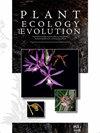大规模地理因素如何影响功能多样性的不同维度:来自山毛榉森林草本层的证据(意大利亚平宁)
IF 1.3
4区 生物学
Q3 PLANT SCIENCES
引用次数: 0
摘要
背景与目的:研究亚平宁地区以高林经营的钙质山毛榉林草本层功能结构与大尺度地理因子的关系。材料和方法:采用随机分层抽样设计,从意大利中部到南部选取163个地块(20 × 20 m)。我们将群落加权均值、功能丰富度、均匀度、散度、分散度和Rao二次熵的效应大小与物种组成变异的主轴相关联。主要结果:地理范围对草本层物种组成的影响不大。然而,我们在研究区域的北部地区发现了功能趋同的证据,在那里与资源保留策略和植物传播相关的特征被过滤掉了。我们没有发现叶物候和授粉类型向北趋同的证据。结论-环境胁迫强度的增加与资源保护策略和无性繁殖相关性状多样性的降低有关。相反,向南冷胁迫强度越低,生态位分配越好,确保了不同资源获取和保护方式的物种共存。本文章由计算机程序翻译,如有差异,请以英文原文为准。
How large-scale geographic factors affect the different dimensions of functional diversity: evidence from the beech forest herb layer (Apennines, Italy)
Background and aims – The research aim was to investigate the relation between large-scale geographic factors and the functional structure of the herbaceous layer of calcareous beech forests in the Apennines, managed as high forest.Material and methods – We selected 163 plots (20 × 20 m), ranging from Central to South Italy, using a random stratified sampling design. We correlated the effect sizes of traits’ community-weighted means, functional richness, evenness, divergence, dispersion, and Rao’s quadratic entropy, with the main axes of variation in species composition.Key results – The geographical range played a weak role in shaping the species composition of the herbaceous layer. However, we found evidence of functional convergence towards the northern sectors of the study area, where traits linked to resource retention strategies and vegetative spread are filtered. We did not find any evidence of convergence northwards for leaf phenology and pollination types.Conclusion – The increase of the intensity in the environmental stress was associated with a decrease of diversity for traits related to resource conservation strategies and vegetative propagation. On the contrary, the lower cold stress intensity southwards fostered a better niche partitioning, ensuring the coexistence of species with different modalities of resource acquisition and conservation.
求助全文
通过发布文献求助,成功后即可免费获取论文全文。
去求助
来源期刊

Plant Ecology and Evolution
PLANT SCIENCES-
CiteScore
2.20
自引率
9.10%
发文量
27
审稿时长
>12 weeks
期刊介绍:
Plant Ecology and Evolution is an international peer-reviewed journal devoted to ecology, phylogenetics and systematics of all ‘plant’ groups in the traditional sense (including algae, cyanobacteria, fungi, myxomycetes), also covering related fields.
The journal is published by Meise Botanic Garden and the Royal Botanical Society of Belgium.
 求助内容:
求助内容: 应助结果提醒方式:
应助结果提醒方式:


